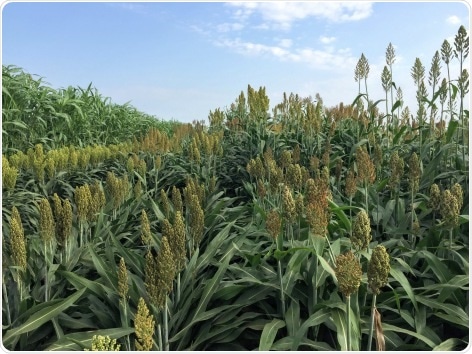Scientists at Iowa State University have used data analytics to investigate “under the hood” of the systems that regulate how genetics and changing environmental factors interact throughout the critical phases of plant growth.

Sorghum plants grow in an Iowa field. ISU researchers showed genomes interact with environments during plant development to determine final height in sorghum. Image Credit: Qi Mu.
Recent research published in the academic scientific journal New Phytologist looks at how temperature variations impact the height of sorghum plants, and the researchers say the findings might help breed more robust crops as well as give information on systems that play a key part in plant growth.
The study focuses on the idea of phenotypic plasticity, or how a character may change as a result of environmental factors. For example, a plant in a dry environment may grow to a different height than a plant in a humid environment with the same genetics.
According to Jianming Yu, a professor of agronomy and the Pioneer Distinguished Chair in Maize Breeding at Iowa State University and the study’s corresponding author, recognizing plasticity can help plant breeders design crop varieties that will operate well under a variety of environmental conditions.
However, focusing just on a plant’s final mature traits provides an imperfect view of plasticity. Instead, the current study looks at the rate of sorghum growth between 40 and 53 days after planting, which is a vital stage of development. The researchers were able to investigate the processes that drive sorghum’s phenotypic plasticity in more depth by focusing on that rapid-growth period of the plant's life cycle.
Looking at the developmental phase allows us to look under the hood to see what causes the final mature traits.”
Jianming Yu, Study Corresponding Author, Professor, Iowa State University
Over several years, the researchers collected data on sorghum, a globally farmed grain crop, growing in Iowa, Kansas, and Puerto Rico. Plant height was measured multiple times throughout the growing season, resulting in a large dataset on which the researchers operated statistical regression analyses to better understand the relationship between height and diurnal temperature change, or the temperature difference between nighttime lows and daytime highs.
They discovered that increases in diurnal temperature change resulted in shorter plants. The pattern was especially noticeable about 40 to 53 days after planting when the plant was at its most important growth stage.
We found that these genes actually interact with environmental stimuli and control the maximum growth rate as well as time to reach maximum growth rate. And that eventually determines the final plant height.”
Qi Mu, Study First Author and Postdoctoral Research Associate, Agronomy, Iowa State University
Plasticity and climate change
Yu explained that the importance of understanding phenotypic plasticity is increasing as climate change increases. Farmers and plant breeders will need improved techniques to anticipate how crop types will perform under diverse environmental settings as climate change produces more dramatic weather fluctuations.
For example, Yu stated that climate change might cause nighttime temperatures to rise in some areas, which would have major implications for agricultural cultivation, as shown in the study.
Plant breeders will be able to build more precise techniques for forecasting how crops will perform across a range of environmental situations as a result of research into phenotypic plasticity, added Mu.
With climate change, crops need to adapt to different climates and environments. In order to breed crops that are more adaptive we have to understand the mechanism of how they respond to environments. With that knowledge, we can design resilient crops that thrive in future environments,”
Qi Mu, Study First Author and Postdoctoral Research Associate, Agronomy, Iowa State University
According to Xianran Li, a former adjunct associate professor of agronomy at Iowa State and a co-corresponding author of the study, the findings were discovered after analyzing 3,500 phenotype records collected over four years and further validated with 13,500 phenotype records collected over another four years.
Li concluded, “Thousands of weather and genetic fingerprint datapoints were mulled over as well.” Li now works at the US Department of Agriculture’s Agricultural Research Service as a research scientist.
Source:
Journal reference:
Mu, Q., et al. (2021) Phenotypic plasticity in plant height shaped by interaction between genetic loci and diurnal temperature range. New Phytologist. doi.org/10.1111/nph.17904.